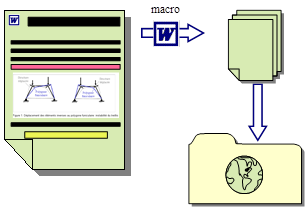5. Preparing lessons: an author-centric approach
Preparing the lessons is a very important task. It my seem trivial, but lessons can only be prepared by very competent people! Typically, it is professors who, with the help of close assistants, prepare their lectures and lecture notes. This will also be the case for the preparation of this web-based course. Since the material displayed on the web site will be the main material available to students, it is even more important that it be of very high quality.
It is therefore likely, and desirable, that the course material be prepared by the professors themselves. They are the main author, and the production sequence must be very author-centric in order to benefit from the input of the main authors. This approach is also best suited to ensure that further development will not be hampered by the fact that teachers cannot directly change their material, and are unable to have their courses changed after the initial development team has been disbanded.
Our authors are very important persons, not only to prepare the first version of the course, but also to enhance its contents over time, after seeing the reactions of the students.
Before starting with this work, it is useful to prepare a short table of contents, with a list of possible examples and exercises. The actual writing of the lesson can be done using any text editor, but the most efficient way is to use the predefined Microsoft Word template, that includes a set of styles to help define the structure of the lesson. This Word document can include all kinds of pictures (photos, drawings, logos, equations) and can also include links to other parts of the present lesson, to other lessons or to external web sites.
 |
Figure 3: Process of transformation and publication from a Word document to the web site
When a sufficient level of quality is reached, the Word document can be translated into a series of web pages that will then be published on the web (fig. 3). The interest in this approach is that, after the Word file has been converted to HTML, it can be further edited by the author. Because the process of converting a Word file to HTML happens automatically, it can happen many times, allowing authors to start publishing documents at an early stage, instead of waiting until the document has reached complete maturity before transforming into HTML for publication. Should the development platform or web common language change in the future, this would have no impact on the existing course material. Only the translation programs would need to be adapted, which can be organized as a relatively small project, without requiring the reconstitution of a full design team.